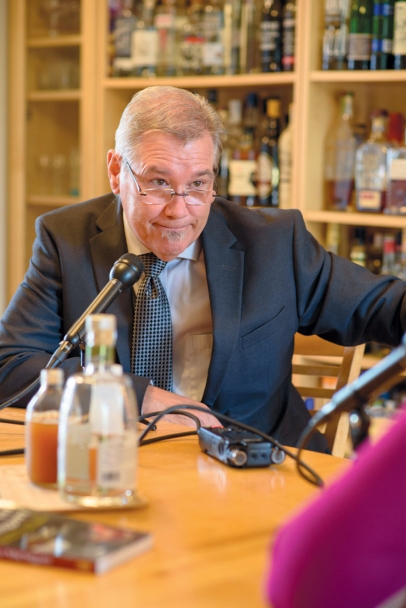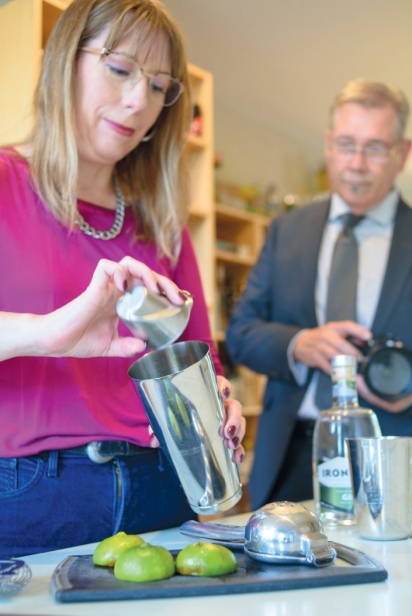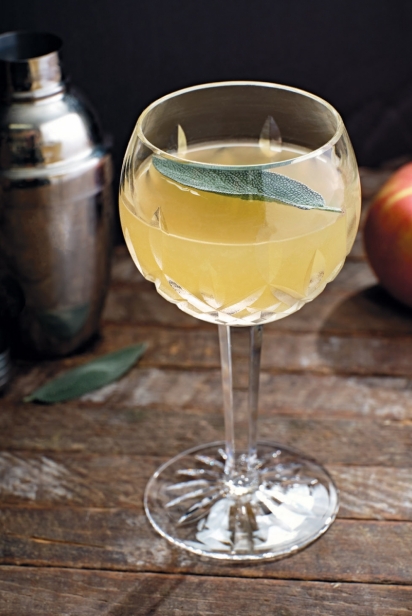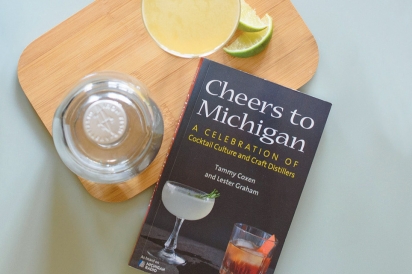The Art of the Craft Cocktail
Tammy Coxen and Lester Graham on the joy of artisan cocktails
She’d created artisanal chocolates. She’d hosted gourmet underground supper clubs. She’d led food and beverage tours in places with rich culinary and potable histories, like New Orleans. And Tammy Coxen had founded her Ann Arbor company, Tammy’s Tastings, in 2006.
But when she met award-winning Michigan Radio journalist Lester Graham, he asked her: “What do you want to do with your life?”
Coxen’s answer: Cocktails.
“I was going to a meeting the next day, with the Ravens Club [in Ann Arbor], which had just opened. I pitched doing a cocktail class with them. They said yes. Lester came to the very first one.”
She’d also heard about a cocktail segment on a public radio show in Cincinnati. Would Michigan Radio be interested in something along those lines?
As it happened, Graham was about to start hosting the Friday edition of “Stateside,” a daily feature on Michigan Radio.
“After a week of heavy political ramblings, environmental issues, something lighter sounded just right,” he says.
When he ran it by his boss, Zoe Clark, she agreed, with one stipulation: The segment needed to feature Michigan products.
The first episode of “Cheers!” aired in January 2016; the show has been running ever since, every other Friday as a part of the “Stateside” broadcast. (While the pandemic initially caused some disruption, the show is now back on its regular schedule.) Coxen typically takes a seasonal ingredient—maybe berries or cherries—and then talks Graham through exactly how to make the drink of the week. Michigan producers are featured, and the two trade names of tasting rooms they’d like to visit. Snobby terms and pretentious descriptions don’t make it over the “Cheers!” threshold; these are two friends experimenting with drinks and having a blast. And if one of Coxen’s concoctions doesn’t quite hit the mark, Graham tells it like it is.
They teamed up to create the book Cheers to Michigan: A Celebration of Cocktail Culture and Craft Distillers (University of Michigan Press, 2019), featuring Coxen’s recipes and Graham’s photos.
Their spirited banter seems well matched, as you can tell from our recent interview:
edibleWOW: So what’s the difference between a craft cocktail and a regular old cocktail?
Lester Graham: I think it comes down to care. A mixologist who cares about ingredients is going to serve with fresh-squeezed juices, use decent-quality spirits, pay attention to detail. We think of these folks as artists and alchemists.
Tammy Coxen: Totally agree! This is an old art form. People have been mixing alcohol with other things back to—arguably—the early 1800s. There’s an 1806 recipe that mixes a spirit with sugar and bitters; it’s basically the original Old Fashioned, which was a morning drink. From there, the term “cocktails” became more generic as a term for mixed drinks, all sorts of different things, like flips and slings and sours and nogs.
eWOW: You’ve learned some great distiller back stories, I bet.
Graham: Here’s a good example: Ari Sussman called me a couple of years ago. He’d found out all about Rosen Rye, sent me pages of history of how it was brought to Michigan by a Russian Jew in exile. He worked at MSU—which wasn’t even MSU yet—and he’d brought over rye seeds from the old country. It had great flavor, but it would cross with other types of rye. So they started growing a pure variety on Manitou Island. Ari tracked it down and now, with Mammoth Distilling, they’re working on making their own distilled version of Rosen Rye.
Coxen: I’m currently in love with Norden Aquavit. It was started by Summer Ransom-Cleveland, a Michigander of Swedish descent, and her husband, Robyn Cleveland, is the distiller. It’s such a great spirit, with an incredible heritage, and Michigan has proven to be a great home for it. In just a few short years they’ve gotten all kinds of attention.
eWOW: If I’m new to craft cocktails, where do I start?
Coxen: Gin. People have associations with gin that it’s piney, tastes like a Christmas tree. But there’s so much variety. Hendricks has flavors of cucumber and rose, and some of the Ann Arbor Distilling gins are more fruity or floral. There’s one for everyone.
eWOW: Do you have a favorite spirit to work with?
Graham and Coxen in unison: Rye.
Coxen: And aquavit.
Graham: Whiskey, in general. It’s a golden time for distillers who are putting out whiskey. They’ve had time to understand how to blend, understand the grains, the type of barrel; they’re really coming into their own. Michigan’s far ahead of many other states in its creative approach to whiskeys.
Coxen: Michigan is playing around a lot. There’s a farm in Ann Arbor that’s experimenting with whiskey from polenta grain.
Graham: When the book came out in 2019, we tried to list all the distilleries at the end. Two years later, there are double the number.
eWOW: Tammy, you also teach courses in alcohol-free cocktails.
Graham: I call them mocktails.
Coxen: Don’t use that word.
eWOW: What’s wrong with “mocktails”?
Coxen: It’s a little … diminu-izing. Is that a word? I teach an entire class on zero-proof cocktails. Nonalcoholic spirits are an absolutely huge trend in the industry right now. The same kind of craft is involved. It’s just zero proof.
eWOW: How did COVID change things?
Coxen: I had to switch to teaching my cocktail classes online, and so far I’ve taught about 600 online classes. I have a lot of different topics, so people come again and again. It’s been fun watching my regulars get into it, and some of them have told me they had to get a new liquor cabinet!
eWOW: Any plans for a follow-up book?
Graham: Cheers to Michigan has the first two years of episodes that we did. We have another three and a half years that we could put in Cheers 2 Michigan.
eWOW: Any final advice?
Coxen: Drink for quality, not quantity. Alternate with water, or with nonalcoholic drinks, which allow you to extend your evening without overconsuming.
To learn more about what Lester Graham and Tammy Coxen are concocting, go to michiganradio.org/cheers and tammystastings.com.








